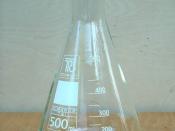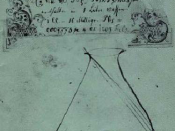Abstract:The Wittig Reaction is a nucleophilic addition in which an alkene is formed as a product. Both the E and Z isomers of the alkene result. Substituents on the aromatic aldehyde affect the E/Z ratio of products that form. In this experiment, a nitro group was used as the substituent in the ortho, meta and para positions, with benzaldehyde as the control. Each of the four aldehydes reacted with (carbethoxymethylene) triphenylphosphorane to produce ethyl cinnamate, ethyl-3-(2-nitrophenyl)acrylate, ethyl-3-(3-nitrophenyl)acrylate, and ethyl-3-(4-nitrophenyl)acrylate. The prediction was the closer the substituent was to the aldehyde, the greater the ratio of E/Z isomers; benzaldehyde was predicted to result in the most similar ratio of E/Z isomers. The ratios of E/Z isomers were determined by using the NMR spectra obtained. A percent conversion was also obtained. Ethyl-3-(2-nitrophenyl)acrylate had a ratio of 9.03:1, ethyl-3-(3-nitrophenyl)acrylate had a ratio of 5.2:1, ethyl-3-(4-nitrophenyl)acrylate had a ratio of 1:1 and ethyl cinnamate had a ratio of 9.3:1.
The results for the compounds except ethyl cinnamate supported the hypothesis that the ratio would be closer to 1:1 as the substituent moved further from the carbonyl.
Introduction:The purpose of this experiment is to determine how a nitro group on benzaldehyde affects the stereoisomer formation of the alkene formed in a Wittig Reaction. The nitro group is substituted in the ortho, meta, and para positions, and benzaldehyde serves as a control. The ylide used is (carbethoxymethylene) triphenylphosphorane. Through the utilization of NMR spectroscopy, the products of the reactions will be analyzed to gain a ratio of E /Z isomers.
Reaction Equations:Ethyl cinnamate from BenzaldehydeEthyl-3-(2-nirophenyl)acrylate from O-nitrobenzaldehydeEthyl-3-(3-nitrophenyl)acrylate from M-nitrobenzaldehydeEthyl-3-(4-nitrophenyl)acrylate from P-nitrobenzaldehydeIn 1954, Georg Wittig, a German chemist, discovered the Wittig Reaction. In 1979, Wittig won a Nobel Prize in Chemistry due to the Wittig Reaction's synthetic potential to form a variety of different alkenes. Today,


